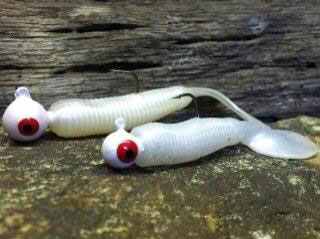 Cold Weather Bass
Cold Weather Bass
Catching Bass under the ice or in cold weather can be difficult, but not impossible. For those brave enough to take the challenge, we found some great tips for cold weather Bass fishing. This first tip is from World Fishing Network and covers cold weather without the need to drill a hole through the ice. Below that you can find out how to locate and catch Bass on an ice covered lake or river.
How important is retrieve speed in cold water? Some anglers may tell you they fish just as fast in winter as they do in spring. However, most successful cold-water anglers will tell you slowing down the presentation is the best.
A grub can be one of the most effective bass lures for cold water. A 4-inch curly tail grub on a 1/4-ounce jig head can be all that is needed to catch your share of bass. Target steep, chunk-rock banks with as much as a 45-degree slope. Bass prefer these areas because they can make extreme depth changes by moving up and down the water column to feed without using much energy.
See full story on worldfishingnetwork.com
Ice Fishing For Bass
Below are some great tips for you if you are willing to go out on the ice to look for Bass. Finding the right location to do a little cold weather Bass fishing is probably the biggest challenge. Ice fishing for Bass may not be for you, but if you do decide to go ice fishing for Bass, these tips from In Fisherman will be the most important to consider.
Lake ice is the substance of Alices looking glass. Things live on the other side. Punch holes in the looking glass and you can see them. Reduced through distance and layered filters of depth, or magnified by the lens of an underwater camera, active bass can be seen cruising along very slowly one to five feet above bottom. Inactive bass seem excessively torpid, laying on bottom in a trance.
Largemouths prefer soft-bottomed, weedy areas and seldom seem to winter much deeper than 30 feet. During milder winters they stay close to healthy, green, deep weed edges. Smallmouths typically winter near hard-bottom points or on isolated rock humps 40 feet down or deeper where they have that option, but often rise shallower when active.
Stick to the main lake to find either species. Bays are seldom homes for wintering bass. For largemouths, look for enclosed or isolated basins with a maximum depth of 20 to 30 feet, and then find the last remaining stands of thick, healthy weeds around the rim of that basin.
See full story on in-fisherman.com
